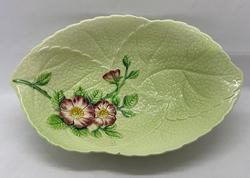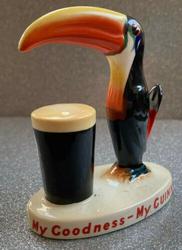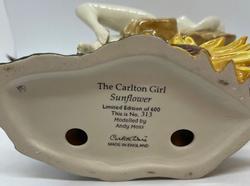Carlton Ware
Carlton Ware was a British pottery manufacturer based in Stoke-on-Trent, Staffordshire. The company was known for its innovative designs, high-quality craftsmanship and use of vibrant colours.
The company was founded in 1890 by James Frederick Wiltshaw, William Herbert Robinson and James Alcock Robinson. Initially, they named their company Wiltshaw & Robinson. The trademark “Carlton Ware“ was introduced in 1894, and the company’s factory was renamed the Carlton Works.
Carlton Ware gained popularity in the early 20th century for its innovative designs and use of vibrant colours. The company was known for its high-quality craftsmanship and attention to detail. They produced a variety of items, including tableware, decorative pieces, vases and figurines.
Crinoline Lady Cruet Set
One of the distinctive features of Carlton Ware is its use of intricate and elaborate patterns. They incorporated various styles and influences into their designs, including Art Nouveau, Art Deco and Oriental motifs. Many of their pieces feature hand-painted details often with gold or silver accents. An accident at the Stoke-on-Trent railway station was the cause of the death of James Wiltshaw in 1918. Control of the company passed to his son, Frederick Cuthbert Wiltshaw. The company continued to expand and in 1930 they acquired Birks, Rawlins & Co. During the late 1930s Carlton Ware introduced a new series of table-ware, with boldly embossed floral and foliage patterns such as Fox-Glove, Waterlily, Wild Rose and Anemone. This series continued in unbroken production into the 1960s, although later designs were progressively simplified to reduce the high cost of hand-painting.
The availably of new techniques using automated high temperature kilns allowed improved high-lustre table ware in the "Royale" brand to be introduced in 1949, and this continued to be produced into the early 1970s.
The company then concentrated on novelty items, one of the most famous Carlton Ware novelty patterns was “Walking Ware” designed by Roger Michell, which features teapots, cups and other items shaped like legs and feet. This whimsical design became highly collectable and has remained popular among collectors.

A Walking Ware teapot and teacups

Carlton Ware Walking Ware Salt and Pepper Pots
Carlton Ware is also famous for the ceramic toucans it made as promotional items for Guinness.
The company was renamed Carlton Ware Limited in 1958 and following the death of Frederick Cuthbert Wiltshaw in 1966 the company was sold to Arthur Wood and Sons. During the mid-20th century, Carlton Ware faced challenges due to changing consumer tastes and increased competition. The company went through various ownership changes and reorganisation. In the 1970s, increasing fuel and labour costs seriously affected Carlton Ware's ability to continue producing elaborate hand-painted items and changing tastes dictated the introduction of more modern shapes and patterns. In the 1980s the production of Carlton Ware shifted to more decorative pieces and limited-edition items.
The Sunflower Carlton Girl
Today vintage Carlton Ware pieces are sought after by collectors worldwide. The company’s colourful and unique designs continue to be appreciated for their craftsmanship and artistic value. Although the original company is no longer in operation, Carlton Ware pieces can still be found in antique shops, online auctions and private collections.


A collector who loved the ice-cream colours of her Carlton Ware collection housed in the kitchen.









